Age Related Macular Degeneration
What is Macular Degeneration?
The retina is the layer of specialized nerve tissue lining the back of the eye that allows you to see. The macula lies at the very center of the retina. Age-related macular degeneration (AMD) is a condition in which the macula is damaged as it ages, causing blurry and distorted vision. The condition affects both distance and close vision and can make some activities (like threading a needle or reading) very difficult or impossible. More than 13 million people in the United States have AMD. Macular degeneration is the leading cause of severe vision loss in people over 65.
What causes Macular Degeneration and who is at risk?
The exact cause of macular degeneration is unknown. AMD is clearly related to age. We also know that both genetic and environmental factors are important in the development of AMD. From the genetic side, women, Caucasians, lightly-pigmented people (blond hair, fair skin, blue-eyed), and those with a strong family history have a higher chance of developing AMD. From the environmental side, smoking, high blood pressure, high cholesterol, and obesity have been linked to the development and progression of AMD.
Are there different kinds of Macular Degeneration?
We often refer to two types of AMD: wet and dry. Please read further to learn more about these two facets of AMD.
Dry AMD
This is the most common form that accounts for 90% of cases of AMD. In dry AMD tiny mounds of yellowish material called drusen collect under the retina (figure 1). Over time the drusen can cause damage to the retina resulting in vision loss. This form of the disease is usually very slow, taking years or decades to cause varying degrees of visual symptoms, from minor to significant. Most people with dry AMD retain good vision for their entire lives, although vision can be impaired in those with advanced dry AMD.
Wet AMD
Wet AMD always starts out as Dry AMD, with a collection of drusen in the macula. If this progresses to wet AMD, abnormal blood vessels begin to grow into the retina. The abnormal blood vessels are very fragile and can bleed and leak fluid, leading to vision loss (figure 2). Although only about 10% of people ever develop Wet AMD, it accounts for 90% of all of the severe vision loss from AMD.
What are the symptoms of Macular Degeneration?
AMD does not cause any pain. The symptoms of dry and wet AMD can be different for different people. Often there are no symptoms at all, especially with dry AMD. As the AMD gets worse you may notice blurry vision, a dark or gray spot in the center of the vision, and distortion of the vision. Straight lines may appear wavy. As AMD gets more severe, you may find it hard to read at all or to recognize faces at a distance. The symptoms of dry AMD usually appear very slowly over many months or years. The symptoms of wet AMD usually develop suddenly.
How is Macular Degeneration diagnosed?
Your retina specialist can diagnose AMD by dilating your pupils and examining the retina. The diagnosis can be confirmed through specialized testing that can be done in the office. A high-resolution scan of the retina called an OCT can give information about how much damage the AMD has caused and can help to follow the disease after treatment (figure 3). In the case of wet AMD a special dye test called a fluorescein angiogram is used to determine where the abnormal blood vessels have grown and how much they are leaking (figure 4).
How is Macular Degeneration treated?
Unfortunately there is no cure for AMD. However, the treatment for macular degeneration continues to evolve and we are able to help many more people with AMD than ever.
Dry AMD
Currently there are no treatments available, however there are clinical trials underway that may lead to new treatments. This form of the disease is usually very slow at causing vision loss, taking years or decades to cause significant vision loss. Most people with dry AMD lead normal lives and have good vision for their entire life.
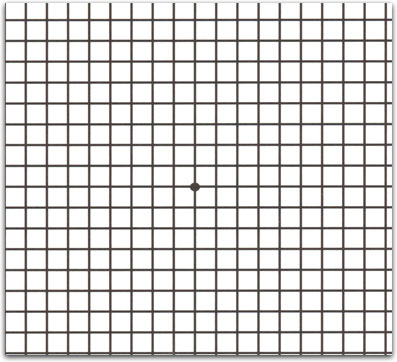
Normal Amsler Grid
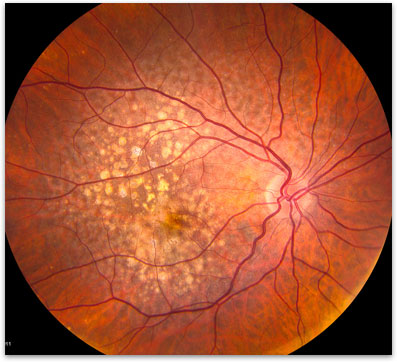
Figure 1. Dry AMD with drusen collected under the retina in the macula.
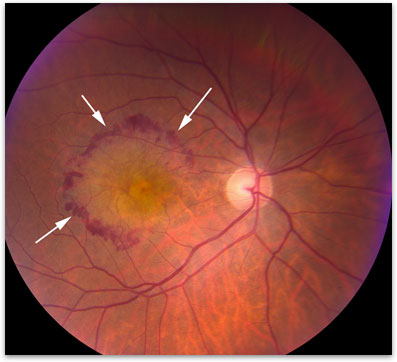
Figure 2. Wet AMD can result in bleeding in the macula.
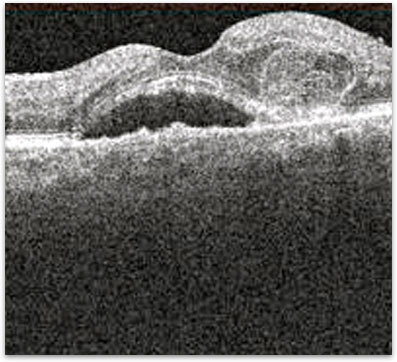
Figure 3. OCT of AMD
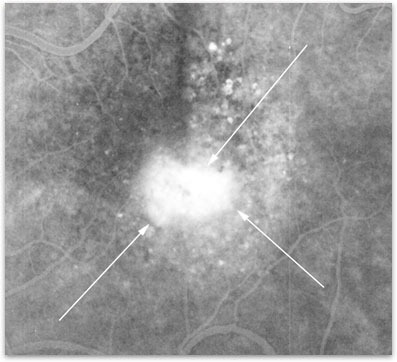
Figure 4. Fluorescein angiogram of wet AMD. The white spot in the center is the area where the blood vessels are leaking.
Wet AMD
Today the main treatment is medication. There are currently a number of medications available but they all work in the same way. The medications act to block VEGF, a specific chemical in the eye that causes the abnormal blood vessels to grow. The medications are called VEGF blockers and different brands and formulations are available. All of these medications are given by an injection into the eye .Your retina specialist can talk with you about what medication may be best for you particular case of wet AMD. Other treatments that are occasionally helpful in AMD laser surgery and photodynamic therapy (PDT). Laser surgery can destroy the abnormal blood vessels. PDT involves injecting a light-activated drug into the arm. The drug then travels through the body. A cold laser is used to activate the drug traveling through the abnormal blood vessels in the eye, which helps to seal them.
What about vitamins for AMD?
A large clinical trial called the AREDS trial has shown that for some people with AMD antioxidant vitamins can be helpful. The most recent version of the study is the AREDS 2, and provided the most up-to-date vitamin supplement formula, containing high levels of vitamin C, vitamin E, lutein/zeaxanthin, copper and zinc and can help prevent vision loss in certain people with AMD. These vitamins are not helpful for all people with AMD. You can talk with your retina specialist about whether you may benefit from taking eye vitamins. These vitamins can be bought in drug stores and supermarkets and are sold as Ocuvite, Preservision, or I-CAPS among other brands. To learn more about nutritional supplements and AMD click here.
What else can I do to protect my vision?
People with wet and dry AMD should monitor their vision each day by checking an Amlser grid. You should call the office if you detect any new changes on the Amsler grid card or if you’re experiencing new symptoms of blurring, distortion or visual loss otherwise. If you have dry AMD, you should have a dilated eye examination by your retina doctor at least once each year. Consider taking antioxidant vitamins if you have moderate AMD.
It is especially important for those at risk for AMD to maintain a healthy lifestyle, eat a diet rich in antioxidants, and avoid smoking.

